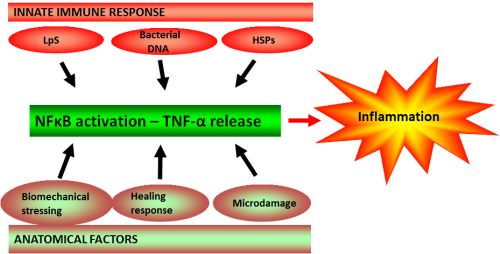Mechanical Model of AS
Introduction
This page explains the mechanical model for Ankylosing Spondylitis and the related Spondyloarthropathies. This scientific theory was published at the turn of the millennium and is explained here in terminology for the non-expert [1].

|
| Things that happen at the enthesis including mechanical stress and microdamage can trigger master regulators of immunity including powerful regulators of inflammation called Transcription Factors. These include NF-kappaB which in turn drives the production of chemicals that drive inflammation. One of these is called TNF but there are others including IL23 and IL17. The events taking place in the gut act like "smelling salts" to the immune system and further stimulate these chemical responses that drive inflammation. If Ankylosing Spondylitis patients, the HLA-B27 gene increases the magnitude and chronicity of inflammation and results in disease development. |
Anatomical Factors and Mechanical Stress
The anatomical factors in AS include the three following areas:
A) Biomechanical stressing can directly lead to immune system activation [2].
B) Biomechanical stressing may be associated with tissue microdamage. This in turn leads to microscopic inflammation.
C) Biomechanical stressing and microdamage are associated with a normal healing response. An exaggerated healing response at the enthesis may result in inappropriate and excessive new tissue formation such as new bone in the spine that occurs in AS [3].
Innate Immune Responses
The top panel of the scheme shows the Innate Immune Response. In the case of AS patients there is evidence that microscopic leakiness of the gut. This allows access of fragments of bacteria (germs) into the circulation and these can get deposited at the enthesis and other locations.
The innate immune system senses "danger signals" and bits of germs inside the body tissues including the enthesis activate the immune system. It is important to appreciate that the innate immune system recognises fragments of dead germs so living bugs are not needed to trigger disease. This is why antibiotics have no proven role.
The innate immune system is also directly activated at the sites of microdamage at the enthesis. These combinations of factors fools the innate immune system into a full state of activation.
Innate Immunity then primes the adaptive immune system which is capable of memory and learning. HLA-B27 is part of this system and this is the major contributor to the chronic nature of AS.
As a result patients with AS get disease at characteristic sites of high mechanical stressing that is typical of entheses and other related structures.
References



Resources
Hindawi Publishing Corporation article on Danger Signals and how they activate innate immunity following injury.
Introduction to Immunology Tutorial a more detailed description of innate and adaptive immunity
Todar's Online Textbook of Bacterology Immune Defense against Bacterial Pathogens: Innate Immunity.